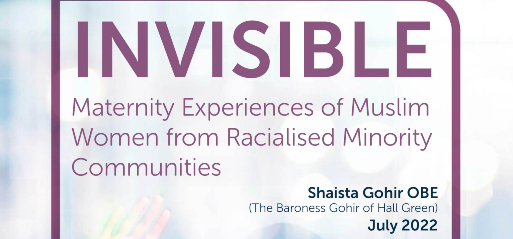
Nadine Osman
Pregnant Muslim women in the UK are more likely to have their labour induced, suffer a postpartum haemorrhage, undergo a caesarean, and are less likely to receive an epidural for pain relief.
These are just some of the alarming findings of a parliamentary report examining their birth experiences.
Co-launched by the All-Party Parliamentary Groups (APPGs) on Muslim Women and the Muslim Women’s Network UK on July 13, the report uncovered “a culture of maternity abuse” that is contributing to 1 in 5 Muslim women rating their maternity care as ‘poor’ or ‘very poor’.
In contrast to the Ockenden Review findings published in March, which noted a trend toward natural labour, this research involving a survey of over 1,000 women, in-depth interviews and a focus group, found that Muslim women were being over-medicalised, resulting in glaring inequalities in their labour, birth and post-birth care.
The report titled Invisible—Maternity Experiences of Muslim Women from Racialised Minority Communities, explains the spotlight has been cast on race as an explanation for poor maternity outcomes, with religious discrimination being overlooked, meaning that the maternity experiences of Muslim women are hidden.
“Given that one in three members of BAME communities are Muslim, a sizeable number of women who suffer from both racial and religious discrimination are not being given a voice,” concluded researchers.
The report found that Muslim women were “being bullied” into accepting potentially risky labour inductions without reasonable medical justification.
According to the report Muslim women were (1.6 times) more likely to have their labour induced; (1.5 times) less likely to be given an epidural for pain relief; (1.4 times) more likely to have an instrumental birth; (22.4 per cent) more likely to suffer a postpartum haemorrhage; (2.1 times) more likely to be in prolonged labour and (1.3 times) more likely to undergo an emergency caesarean.
The research also found hierarchy in bias, where women from specific sub-ethnic groups, such as Bangladeshi, Arab, and Black African women and Asian ‘Other’ women have far worse experiences.
When evaluating maternity care, the current approach of lumping women together into broad groups such as Black, South Asian, and others misses the differences in health inequalities between the various subgroups of women and is an example of systemic discrimination. If women are invisible in data analysis, their maternity care will not be improved.
For example, Arab women are not mentioned as a minority ethnic group to be concerned about, yet the survey suggested they were amongst the groups with the worst experiences and most likely to have prolonged labour and vaginal tears.
Of the South Asian group, Bangladeshi women were most likely to have had their labour induced, an instrumental birth, an emergency caesarean and to have suffered from an infection after giving birth. Pakistani women were more likely to experience excessive blood loss. Black women from all ethnicities were the least likely to be given pain relief.
Another group not mentioned in maternal inequality discussions is Somali women, yet they provided the most unfavourable assessments of healthcare professionals – even describing their maternity experiences as “horror stories” and their care as “dangerous” and that they “felt lucky to be alive.”
They described being treated as “less than human” and spoke of excessive physical force being used. For example, one woman said she felt like her whole womb had been pulled out.
In a statement to The Muslim News Baroness Gohir, author of the report, and CEO of Muslim Women’s Network UK, said, “Every year thousands of Muslim women are having traumatic experiences and being put in life-threatening situations that are avoidable. Sub-standard maternity is no doubt contributing to maternal mortality, neonatal deaths, and stillbirths.
The lack of compassion, respect and dignity shown to women was also shocking. In one extremely sad case, the baby died before birth due to a catalogue of errors. Even though the staff knew the woman was delivering a stillborn baby, she was not provided with any pain relief despite requests. She was also not checked upon for several hours at a time and when she eventually was, four students were bought in without her permission. Such appalling treatment during such a traumatic time is unacceptable.”
The report found staff treated women less favourably because of their race, ethnicity, faith, clothing, and accent. Comments included: “All you people do is make babies… I hope this one can speak English,” and “I see five of you lot per day.” Women spoke of “feeling humiliated,” being “mocked”, “feeling like an experiment”, being “made to feel like a nuisance” and “feeling unheard and unseen”.
Stereotypes that assume South Asian women are exaggerating their concerns contributed to them not being listened to or believed that they were about to give birth until midwives saw the baby’s head crowning.
There were examples of women resorting to taking off their hijab or dressing in more Western clothes because they noted a difference in attitude. Dr Iram Sattar, GP and Co-Chair of Muslim Women’s Network UK, said, “This report makes for difficult and uncomfortable reading, especially being a healthcare professional. It made me reflect on my practice and whether I give more time and care to those who know their rights and are more likely to complain and less time and care to those who don’t know their rights.”
The report makes four major recommendations, which are: Better data collection, analysis and utilisation of equality data to hold individuals and organisations to account, and better-tailored maternity services to meet the needs of ethnically diverse local populations.
A cultural shift in attitudes and behaviours towards racialised minority communities and improving maternal empowerment through better information provision about their risks, their rights and complaints processes so that they are better equipped to hold maternity care providers to account.